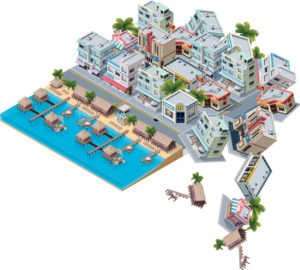When is development stumbling? Bali debates the way forward as it balances the desires of hotel investors against the threat to its nature and culture

Hotel developments in Bali are continuing unabated despite escalating land and construction costs, causing concern among industry members that Brand Bali may lose its identity.
Speaking at the Indonesia Hotel Investment Conference held in Bali in June, Indonesia Hotel and Restaurant Association chairman, Yanti Sukamdani, said: “There are 67 hotel projects in Bali until 2016. I don’t know where these hotels are going to be built, and we have no more rice fields.”
This year, the number of hotel rooms in Bali is expected to hit 34,226, compared with 30,100 in 2013 and 22,000 in 2011.
“When we build more hotels, we also need more supply of water, electricity and food, things that tourism stakeholders need to consider,” said Yanti.
Not excessive, but wrongly placed
Bali has been portrayed as paradise with its rice terraces and rich culture and tradition, but there are fears it will become an urban island like Waikiki or Phuket.
Accor Indonesia-Malaysia vice president for development, Rio Kondo, said: “The interest in building hotels is mind boggling. I have received requests for hotels in the oddest places, with investors deciding to go ahead with the location despite my advice against it.
“So the problem is not necessarily overdevelopment but development in the wrong places. Of the 67 hotels coming up probably half are not feasible…Those building hotels in a mature market like Bali have to be careful.”
Some companies are already exercising caution. Ciputra Property, for instance, has a massive 80ha luxury resort and residential project in Tabanan. General manager for business development, Agustono Effendy, said: “Land prices in south Bali are very high, so we are looking for new areas. We believe developments will shift from Kuta to Seminyak, Canggu and Tabanan.”
Echoing these sentiments, Rio added: “There has been too much development in the south, but there are opportunities to grow in the east, north or west. However, infrastructure is the issue.”
A ring road around Bali is needed to spread developments out to other areas, he suggested.
Beyond Bali, Lombok has also been singled out as an alternative, but development there is still nascent.
Agustono said: “Although it is hard to find a big space in expensive Bali, it is still the best bet for us. Lombok has potential, but will take time to develop.”
Panorama Group group CEO, Budi Tirtawisata, added: “Many investors are eyeing Lombok, but everyone seems to be waiting for someone else to kick off something before considering entrance.”
To restrict or not
With land being costly in Bali, investors have called on the government to relook the regulation that requires buildings not to exceed the height of a coconut tree (up to four or five storeys high).
Rio opined: “It is a very controversial issue….From my discussion with some people, maybe what (the authority should do is) just designate an area where high-rise buildings are allowed.”
However, Budi said allowing high-rise buildings would not help but “would only push prices higher as the interest to build will also increase”.
Still some like Douglas Wallace, general manager of Gending Kendis Luxury Villas & Spa Estate, felt that retaining the current regulation would keep Bali’s character.
“I have a picture of Kuta Beach I took 30 years ago, and although developments have taken place, the view over Legian and Seminyak is pretty much the same because of the restriction on building heights.”
Ida Bagus Ngurah Wijaya, chairman of Indonesian Tourism Industry Association (GIPI) Bali Chapter, said: “Bali’s assets are its people, culture and tradition. Some 80 per cent of the people’s income is from tourism, so Bali cannot be developed the same way as other destinations in Indonesia. Bali without its culture is another Singapore.
“We have seen the Balinese culture diluting in the overdeveloped Badung area (in south Bali). Performances, shows and attractions in the area are dominated by non-Balinese ones.”
Ngurah explained that while the locals were not against development, they did not want development to outpace capacity. As such, high land prices as well as more stringent government regulations and licensing should be the way to go.
Regional cooperation needed
Although Bali’s governor had issued in 2010 a moratorium on principal licences for tourism accommodation in Badung and Gianyar regencies as well as Denpasar municipality, the concept of regional autonomy has placed property development licensing in the hands of the regency and municipality governments.
Ngurah said: “So at the end of the day, it is up to the regencies to decide if and when they should stop issuing licences for hotel development.”
GIPI Bali Chapter, which was established to become the government’s think-tank as stipulated by the Tourism Law, has repeatedly called for the regional government to impose a moratorium on hotel development, Ngurah said, adding that the other problem is that Bali does not have a development masterplan.
“The provincial government has made a draft masterplan, but it needs the approval of all the regencies and municipalities before implementation. The governor needs to lobby the regencies to get the masterplan going.”
In his keynote address at the Indonesia Hotel Investment Conference, former minister of culture and tourism, I Gede Ardika, reminded the industry to consider Bali’s carrying capacity and unique characteristics as a destination.
Ardika, a Balinese who is also a member of the UNWTO committee on Global Code of Ethics for Tourism, said: “The approach that we have adopted so far is unlimited or open-ended development. This is one of the reasons why the world faces global warming. Development with no limitation creates overexploitation of resources.”
He urged that development should be based on what the destination needs and not what the industry wants, pointing out that it is the way of life, nature and culture that make Bali what it is and why travellers keep coming back.
Look ahead, not backward
The urbanisation of Bali is an inevitable direction for the destination, according to Bill Barnett, managing director of C9 Hotelworks, highlighting that the changes that Bali faces have also been occuring across Asia since the global economic crisis in 2008.
“The global financial crisis turned the tables. In the past, we looked to the West, people coming from longhaul destinations,” he said. However, the burgeoning economy in Asia and the surge of low-cost carriers have given rise to more intra-regional travel, changing the game.
“Airlift is a major driver, redefining our destination…Bali and the rest of Asia are dealing with entirely new dynamics.
“What is important for Asians is not the beaches. They are not like the Europeans, who spend one or two weeks on the beach. (With Asians), it’s about retail, about spending money, about tourist attractions; they are also multi-generation travellers.
“So the new Bali is going to look at these new markets and adjust accordingly. It’s not going to go back to the old days which aren’t going to be back,” Barnett quipped.
To that end, urbanisation is not necessarily always a bad idea. “I have heard people saying Bali is overbuilt, but the culture is still here. I have been visiting this place for the last 30 years and (its attractions) are not only the beaches and idyllic locations, but the people. All these continue to exist,” he said.
Alexander Jovanovic, general manager of The Trans Luxury Hotel Bandung, whose owner CT Corp is developing another property – the five-star Trans Resort Seminyak, added: “At Sunset Road, the land price has increased 10 times in the last five years.
“(But) Indonesia has a growing economy and middle class. Young Indonesians are looking for something different and experiential. We should not forget that they are the ones we will be serving in the future.”
This article was first published in TTG Asia, September 12, 2014 issue, on page 6. To read more, please view our digital edition or click here to subscribe.




















